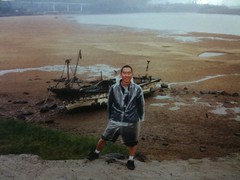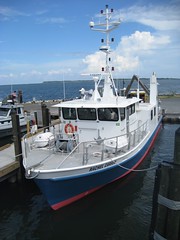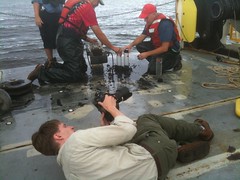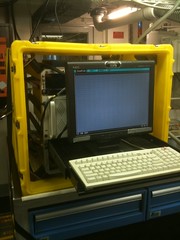People may think oceanographers as scientists using cutting-edge equipment on a comfortable research cruise.
Oceanographic equipment are very expensive because it works under water which is basically stressful environment to machines using electricity due to pressure and 'water' itself. Although this job can be physically challenged due to the characteristics of environment where we work, many research cruises have been built as much as comfortable for scientists. But there are still many oceanographers who want to be dirty, work harder, and avoid any comfort zone at least during the cruise.
Dr.
Jeff Cornwell and Mike Owen (faculty research assistant) at Horn Point Laboratory have been collecting estuarine sediments from all over the U.S. more than two decades. Studying bio-geo-chemical mechanisms occurring under the benthic environment is crucial to understand entire ecosystem responses due to high biogeochemical activities of micro and macro organisms under the sediment. As we cannot understand atmospheric reactions (e.g., climate) without knowing the interaction between atmosphere and earth's surface, we cannot find about the function or productivity of 'water' without the understanding of 'sediment'.
This is why we collected sediment core samples from Chesapeake Bay 'no oxygen' zone to find out the biochemical characteristics of the area.
 |
| Sediment Cores |
Since the accumulation rate of sediment is on the order of 0.5 to 1 cm per year, these sediment cores which are about 30 cm long is at least 15 to 20 years old (maybe older than you!). It not only has a history of the Bay itself, but also kindly provides all scientific information if we are willing to get.
And don't forget that mud is good for your skin, too!!!
 |
| My 17 yr old dog, Ggang-ggang. |









